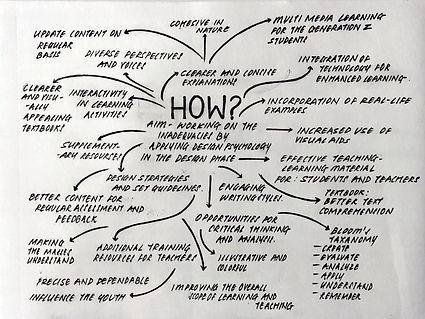
PSYCHOLOGY IN DESIGN
DESIGNING FOR COGNITIVE WELL-BEING

ABOUT
This project aims to explore the intersection of psychology and design, particularly focusing on cognitive well-being in visual communication design and the education sector. It is a unique case study that concludes by integrating principles of design psychology into the creation of educational materials, the project seeks to address design flaws in existing learning materials and promote optimal learning experiences for students and teachers.
PROJECT CATEGORY
Case Study and Design in Print Media
PROJECT YEAR
2024
DESIGN PROCESS

DISCOVER STAGE
Reserch was conducted in the areas of Design psychology, Principles of design psychology, Communication model, Cognitive well-being, Education Sector of India, Subject of History, Interview with teachers and students.
The research concluded with scope of the project focusing specifically on the design aspects of the history textbook used in the Class 10th CBSE
curriculum in India. Design solutions will be proposed within the constraints
of educational standards and curriculum requirements - was the concluding statement.
Educators, students, textbook publishers, designers will be the key stakeholders of this project. A few images that showcase the process of research are presented below.




DEFINE STAGE
Defined Problem Statement and Target Audience
PROBLEM STATEMENT
Inadequacies present in the Class 10 CBSE History textbook lead to significant challenges for both students and teachers, adversely impacting the teaching and learning process and the cognitive well-being of those involved.
WHO - Both students and teachers
WHAT - Inadequacies present in the Class 10 CBSE History textbook
WHY - Adversely impacting the teaching and learning process and
the cognitive well-being of those involved
WHERE - In the classroom or learning environment where the
textbook is utilized
WHEN - Throughout the duration of teaching and learning sessions
involving the textbook
PERSONA 1 - TEACHER

DEFINED TARGET AUDIENCE
The target audience is the students of class 10th in CBSE affiliated schools in India learning the subject of History and the teachers teaching the subject of history to class 10 CBSE students.
PERSONA 2 - STUDENT

IDEATION STAGE
Ideating solutions for the defined problem statement
CREATIVE ANALYSIS OF THE HISTORY TEXTBOOK
DESCRIPTION OF THE BOOK - The textbook India and the Contemporary World - 2 is a soft bound, light weight book.
The color on the coverpage is a rustic shade of reddish brown with pictures scattered allover.
This book is issued by the National Council of Educational Research and Training (NCERT) for the students of class 10, of the CBSE board.
PRODUCT COST - This book is priced at an MRP. of Rupees 180, however theproduct cost may vary in different retail or wholesale markets.







DESIGN STAGE
Execution of the ideas leading to the final outcome
TYPOGRAPHY AND COLOR PALETTE WITH SIGNIFICANCE


VISUAL ELEMENTS AS PER DESIGN RELEVANCY


LAYOUT EXPLORATIONS


FINAL DELIVERABLES
The Final outcome of this design project is in the form of a set of different teaching-learning materials which act as an aid to the textbook of History, Class 10 CBSE. The materials are designed for the chapter of Nationalism in India, the design guidelines can be replicated to create more such creative solutions leading to the cognitive well-being of both students and teachers.
DELIVERABLE 01 - THE NEWSPRINT
The newsprint is a set of four sheets covering topics throughout the chapter.
At the end of every sheet word search puzzle is provided, this is done to increase engagement amongst the students. They are designed in a newspaper style in a way to enhance relatability and solve mobility issues.






DELIVERABLE 02 - THE PICTORIAL ARCHIVES
This is a small, easy to carry picture book with pictures present throughout the chapter in a presentable quality with description about the picture helping to associate better. Every spread also has a QR code to view video references of the picture.





DELIVERABLE 03 - THE TIMELINE
The timeline with important dates and information present in the chapter is creatively showcased in an accordian style timeline. The design style of the tiemline is inspired from retro/vintage tickets, this gives one the feeling of being transported to the era where the event had taken place. This also helps in retaining information and easy memorization.











DELIVERABLE 04 - FLASHCARDS
A set of 8 flshcards is designed, 4 are informative flash cards and 4 are interactive flash cards.
The deliverables are the byproducts of application of design psychology in the execution stage. The delievrables also fit in the NCERT guidelines for textbook design. When used dilligently can lead to effective teaching and learning, thus promoting cognitive well-being.







